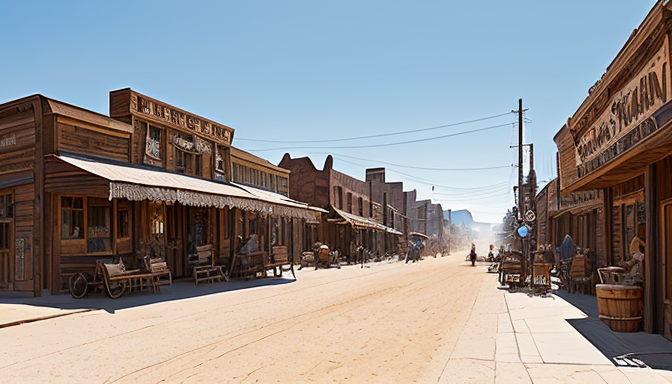The American West has long been a canvas for storytelling, painted with the bold strokes of adventure, conflict, and the pursuit of freedom. Films have played a crucial role in shaping our understanding of this vast and rugged landscape, turning it into a mythic frontier that resonates with audiences. From the dusty trails of classic Westerns to the complex narratives of modern interpretations, these films have not only entertained but also challenged our perceptions of what the West truly represents.
Take, for example, the iconic film “Stagecoach” (1939). This groundbreaking Western didn’t just feature cowboys and outlaws; it introduced a diverse cast of characters, each with their own stories and struggles, thereby reshaping the traditional narrative. Films like this have paved the way for future storytellers to delve deeper into the human experience, illustrating that the West is not merely a backdrop for violence and heroism, but a rich tapestry of cultures and histories.
As we journey through these cinematic landscapes, we begin to see the West through a different lens. The themes of justice, identity, and morality are explored in ways that resonate with contemporary audiences. They compel us to ask: What does it mean to be a hero? Who gets to tell the story? With each frame, these films invite us to reflect on our own values and beliefs, making the Western genre a powerful medium for cultural dialogue.
Influential Westerns and Their Cultural Impact
The American West has always been a land of mystique and adventure, and films have played a pivotal role in shaping our understanding of this rugged frontier. Iconic Westerns like “The Searchers” and “High Noon” not only entertained audiences but also challenged the traditional narratives surrounding heroism and morality. These films often depicted the harsh realities of life in the West, portraying characters who were complex and multifaceted rather than simply good or evil.
Take, for example, “The Good, the Bad and the Ugly”; this film didn’t just present a tale of gunfights and treasure hunting but also reflected the chaotic nature of human relationships against the backdrop of the Civil War. It forced viewers to reconsider their perceptions of right and wrong, making them question who the real hero was. This kind of storytelling opened the door for deeper explorations of themes such as redemption, betrayal, and survival.
Moreover, the Western genre has influenced various aspects of American culture, from literature to fashion. The mythos of the cowboy has seeped into our collective consciousness, symbolizing freedom and independence. Films like “Unforgiven” and “Dances with Wolves” further pushed boundaries, addressing issues of race and violence that were often glossed over in earlier portrayals. These narratives not only entertained but also sparked conversations about the darker sides of American history.
In essence, Westerns have served as a mirror reflecting societal values and conflicts, evolving from simple shoot-’em-ups to profound commentaries on the human condition. They invite us to journey through the West, not just as spectators, but as participants in a dialogue about our past and its implications for the future.

Modern Interpretations of the Western Genre
When we think about the American West, it’s easy to conjure images of rugged cowboys, vast deserts, and epic showdowns. However, the modern interpretation of the Western genre has taken a sharp turn, offering fresh perspectives that challenge traditional narratives. Today’s filmmakers are not just retelling old tales; they are redefining what it means to be a hero, a villain, or even a bystander in this iconic landscape.
Films like “No Country for Old Men” and “The Revenant” have introduced a grittier, more nuanced portrayal of the West. These stories delve into the darker aspects of human nature and survival, showcasing characters who are far from one-dimensional. They invite viewers to question: What does it truly mean to be “wild”? The line between civilization and savagery becomes blurred, forcing us to confront our own perceptions of morality.
Moreover, modern Westerns are increasingly inclusive, featuring diverse characters and stories that reflect the rich tapestry of experiences in the West. For instance, films such as “The Harder They Fall” celebrate Black cowboys and their contributions to the genre, which have often been overlooked. This shift not only enriches the narrative but also resonates with contemporary audiences who seek representation and authenticity.
In this evolving landscape, the Western genre serves as a mirror, reflecting not just the past but our current societal issues. As we journey through these films, we are reminded that the frontier is not just a physical space, but a symbol of the struggles, dreams, and realities that define us all.
Frequently Asked Questions
- What are some films that significantly changed perceptions of the American West?
Several iconic films have redefined how we view the American West. Classics like Stagecoach and The Searchers challenged traditional narratives, showcasing complex characters and moral dilemmas.
- How have modern Westerns evolved from traditional ones?
Modern Westerns often tackle contemporary issues, such as race and gender, presenting a more diverse range of characters. Films like Hell or High Water and Three Billboards Outside Ebbing, Missouri reflect today’s societal challenges while still paying homage to classic Western themes.
- Why are Western films important to American culture?
Western films serve as a lens through which we can examine American identity, values, and history. They often explore themes of justice, freedom, and the rugged individualism that are central to the American narrative.
- Can you recommend any lesser-known Western films worth watching?
Absolutely! Films like Meek’s Cutoff and Dead Man offer unique perspectives on the genre and are definitely worth checking out for a fresh take on Western storytelling.